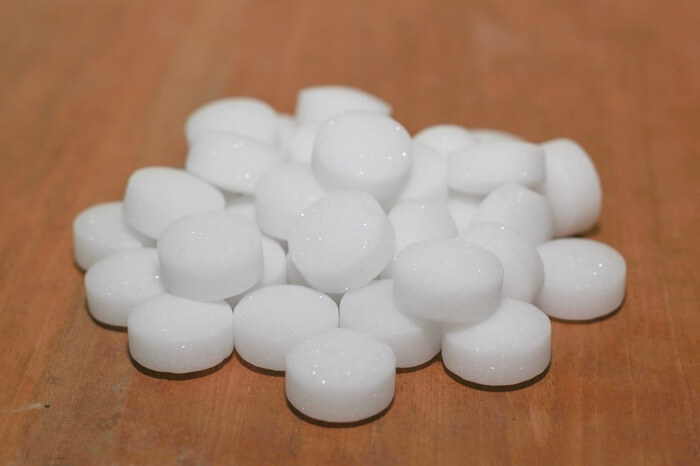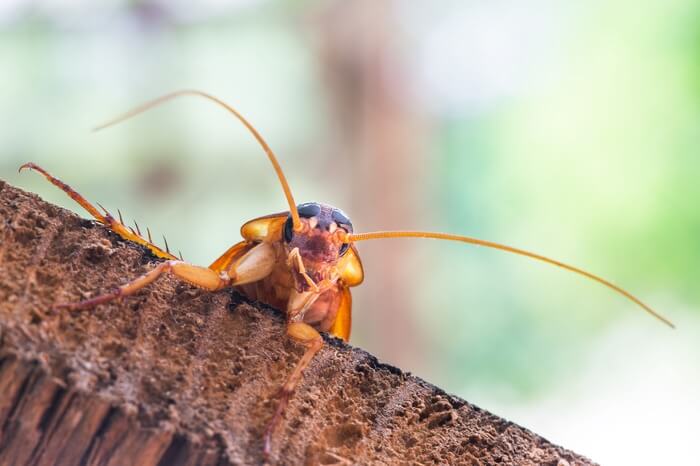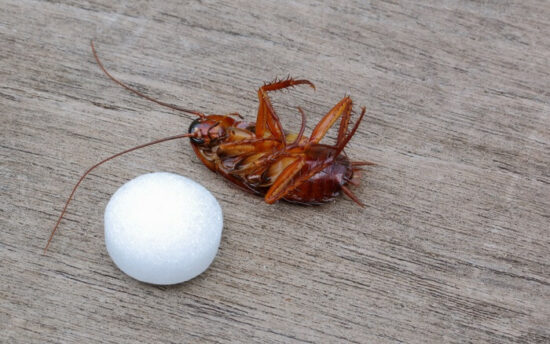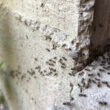If you’ve asked the question, “Do mothballs keep roaches away?” then you’re not alone. These handy little balls have been used for ages to repel various pests, so it’s only logical to wonder if they’ll do the same thing for cockroaches.
The answer to this question depends on a few factors (and your expectations. This guide will help you figure out if using mothballs for cockroaches makes sense for you.
Let’s get started!
Table of contents
What Are Mothballs?
Before we get into if you can use mothballs to repel roaches, let’s define what a mothball actually is. This might seem silly, but many companies sell products they call “mothballs” that aren’t actually the real thing!
Mothballs, as the name suggests, are often used to keep away and sometimes kill small household pests such as moths, silverfish and termites. These whitish, opaque balls are solid at room temperature but give off a toxic gas as they dissolve. While their most common form is a ball, this pesticide can also be found in the form of flakes or small cakes.

Early mothballs were made from a chemical called naphthalene. Even though naphthalene was used in various forms in the 1800’s, it wasn’t used in mothballs until 1948. Since then, mothballs have become so entrenched in our culture, that the word has become part of sayings like, “Put it in mothballs”, or “Take it out of mothballs.”
If you were ever with your mother or grandmother when they took winter clothes out of the attic in the autumn or put them back in the spring, then you will probably remember that pungent, mothball smell. Mothballs were and still are used to keep moths and other pests from destroying wool sweaters, skirts and other types of clothing (they’re sometimes used to help get rid of carpet beetles as well). The sickly smell comes from when the solid mothball slowly changes into a gas, thereby releasing that unique naphthalene smell.
These days, naphthalene is banned in most places, and mothballs are made from camphor or pyrethroids such as transfluthrin. Whatever they are made from, using mothballs is still a very popular way to keep your clothes and other fabric items free from moths and other household pests like cockroaches.
Do Mothballs Keep Roaches Away?
If you’re wondering if mothballs keep roaches away, the answer is yes. These little balls do a reasonable job of repelling cockroaches. But you have to know how to use them properly.
The main reason why homeowners like the idea of using mothballs for roaches is the simplicity. Mothballs are cheap, easy to get your hands on, and easy to use. That’s something you can’t say for many other DIY pest control methods out there!
But it’s definitely not a perfect solution.
As you probably know, cockroaches are notoriously difficult to get rid of once they have made themselves at home. Not only will they get into your food, kitchen cabinets, bathrooms and garages, but they may also carry serious diseases.
That means whatever methods you use to get rid of roaches in your home has to be fairly robust. Many home remedies for getting rid of cockroaches have been tried, and while some work, many of them don’t. So while we’ve already said that mothballs keep roaches away, it might not be a solution that’s heavy duty enough for your problem (it all depends).
You see, using mothballs to repel cockroaches is usually a temporary solution at best. In the short term, the smell and the toxic fumes of the mothballs should keep the roaches away. This method may help for a year or two, but these critters usually get used to the smell, and then you’re back to square one.
Quick Tip: This ability to adapt and thrive in a variety of environments and atmospheres is one of the main reasons why roaches have been around for at least 280 million years.
Do Mothballs Kill Roaches?
While mothballs keep roaches away, this isn’t a method you should rely on if you want to kill them. The gases given off by the mothballs may cause respiratory distress that leads to death, but this is not a common occurrence.
Even if using mothballs manages a few cockroaches, it will still not get rid of the larger problem (unless you’re lucky enough to only see one cockroach). As we mentioned above, the main goal with using the mothball method should be to repel these insects and drive them out of your space.
If you are seeking a method to actually eliminate the roaches in your home, you’ll probably need to find a different way. Using boric acid is a pretty effective way of killing roaches, but remember that it may not be a permanent solution. Roaches, masters in the art of adapting to environments, will often develop a resistance to certain methods.
In conclusion, mothballs will keep cockroaches away (temporarily), but they’re not the best tool if your plan is to kill them.
The Best Ways To Use Them To Repel Roaches
Before we discuss the best ways to use mothballs for repelling roaches, let’s take a quick look at the ways that mothballs should not be used.
Because mothballs are often used to repel roaches, many people think that it’s fine to simply scatter them wherever they think there’s an infestation. This is not something we recommend doing. We will discuss this topic in detail later, but we’d like to briefly mention here that mothballs are for closed containers only, and they should never be used near heat, food prep areas or in open spaces.

Using mothballs to repel roaches can be a tricky thing. On the one hand, you want the noxious fumes to send the cockroaches running, but you also don’t want the smell or the fumes to permeate your home. This is why it’s so important to read the label on the package very carefully. Most of the time, it will tell you that mothballs should only be used in closed containers or very closed spaces.
Quick Tip: This means that despite what you might hear, mothballs are not appropriate roach repellents for under the stove, under the fridge, in your kitchen cabinets or even in your closets. We’re obviously not discouraging you from using mothballs, but you need to use them properly and safely.
Let’s say you have several different categories of items such as clothing, stuffed toys, pillows or blankets and you want to use mothballs to keep roaches away from them. This is especially important if you are moving and you don’t want to take unwanted pests to your new home. Place each type of item in a separate container. It’s very important that the container you use has a very tight-fitting lid.
Put one or two mothballs in each container and close the lid, making sure that the lid is on tightly and securely. You can even tape around the edges to make sure that it’s very tightly closed. This is important because you don’t want any of the fumes to escape into your home.
Place the container in a safe spot, and leave it until you need the items. Using mothballs in this manner should ensure that your precious items are protected and cockroach-free.
When you’re ready to open the container again, make sure that you do it in a well-ventilated area. The fumes from the dissolved mothballs can be very toxic, so good ventilation is key. Also wear a mask and protective gloves to be extra safe.
Safety Considerations
Because mothballs are a pesticide, they should be handled with the utmost caution. We can’t stress enough how important it is to carefully read all packaging instructions. The few minutes it takes to familiarize yourself with the uses and precautions specified on the package can prevent a wide range of health issues or even trips to the emergency room.
Even though most mothballs no longer contain naphthalene, the gases they release are still very harmful (which is why they keep roaches away). That means it’s absolutely critical that you use mothballs only in tightly sealed containers. Placing them in open areas like attics, closets, suitcases or under beds is definitely not recommended. Just remember that once you can smell the mothballs, you are actually breathing in the harmful fumes that are being released.
It may seem obvious, but mothballs should always be kept far away from children and pets. These small, white balls might look like candy or a pet treat, but ingesting a mothball can cause serious injury or even death. Adults should stay away from them as well, and mothballs should never be handled without wearing a mask and gloves. Make sure to use them in an area that is very well ventilated.
Some of the effects of mothball exposure include nausea, vomiting, breathing issues, headaches, dizziness and even hemolytic anemia. Prolonged exposure to mothballs is thought to cause cancer, so using every recommended safety precaution is extremely important. If you notice any of these symptoms in a child, pet or yourself, seek help immediately.
Quick Tip: Because of the very toxic nature of mothballs, we highly suggest using the kind that are made from camphor or para-dichlorobenzene. While they may not be as dangerous as the old-fashioned naphthalene-laced kind, extreme precautions should still be taken when using them. These kinds of mothballs will still keep roaches away, so you don’t need to worry about them being “weaker” than the originals.
As mentioned before, mothballs should only be used in tightly-sealed containers. This goes for storing the unused ones as well. Keep them in containers that are made of non-reactive plastics such as polyethylene or polypropylene.
Conclusion
By now you should know that the answer to the question, “Do mothballs keep roaches away?” is yes, but it depends. Mothballs certainly aren’t a way to kill cockroaches and get rid of an infestation in your home, but they can repel these pesky insects and keep them out of small areas.
So if this sounds like a good fit for your particular cockroach problem, go for it! But if you have a more serious issue at hand, you’ll need to take things to the next level.


